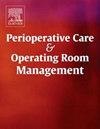A comparative study on ultrasound guided superior laryngeal nerve block and lignocaine nebulization for hemodynamic stress response during suspension laryngoscopy in micro laryngeal surgeries - A prospective randomized double blinded study
IF 1
Q2 Nursing
Perioperative Care and Operating Room Management
Pub Date : 2025-07-25
DOI:10.1016/j.pcorm.2025.100529
引用次数: 0
Abstract
Introduction
Microlaryngeal surgery (MLS) is the commonest endoscopic laryngeal procedure. Insertion of suspension laryngoscopy may lead to hemodynamic response such as rise in heart rate and blood pressure. This hemodynamic instability may cause myocardial ischemia, infarction, arrhythmia, rise of intraocular and intracranial pressure. This study was conducted to compare superior laryngeal nerve block and lignocaine nebulisation in microlaryngeal procedures to circumvent these complications.
Methodology
In this study 46 patients were enrolled in total, out of which 23 patients in Group A received 5 ml of 4 % lignocaine nebulization and Group B patients received superior laryngeal nerve block with 2 % lignocaine. The principal outcome evaluated was the hemodynamic stress response, specifically the alteration in heart rate. The secondary outcomes examined included systolic blood pressure (SBP), diastolic blood pressure (DBP), postoperative sore throat, cough, hoarseness of voice, as well as postoperative laryngospasm and desaturation
Results
In this study significantly lower heart rates were recorded in Group B when compared to that of Group A at 0, 3,5,9 min with a p value<0. 05. Similarly, significantly lower Systolic and diastolic blood pressures were observed in Group B patients when compared to that of Group A (p value<0 0.05). In this study, there is a significantly lower incidence of complications like sore throat and cough in Group B patients than that of Group A patients (P value < 0.01).
Conclusion
Ultrasound guided superior laryngeal nerve block was found to be more effective than lignocaine nebulization to prevent hemodynamic stress response and post operative complications following micro laryngeal surgery.
超声引导喉上神经阻滞与利多卡因雾化治疗喉部微手术悬吊喉镜血流动力学应激反应的比较研究——一项前瞻性随机双盲研究
喉内镜手术是最常见的喉内镜手术。插入悬吊喉镜可引起血流动力学反应,如心率和血压升高。这种血流动力学不稳定可引起心肌缺血、梗死、心律失常、眼压和颅内压升高。本研究比较了喉上神经阻滞和利多卡因雾化在微喉手术中避免这些并发症的效果。方法本研究共纳入46例患者,其中A组23例患者接受5 ml 4%利多卡因雾化治疗,B组患者接受2%利多卡因喉上神经阻滞治疗。评估的主要结果是血流动力学应激反应,特别是心率的改变。次要结局包括收缩压(SBP)、舒张压(DBP)、术后喉咙痛、咳嗽、声音沙哑以及术后喉痉挛和去饱和。结果在本研究中,与A组相比,B组在0、3、5、9 min的心率显著降低,p值为0。05. 与A组相比,B组患者的收缩压和舒张压也明显降低(p值<; 0.05)。本研究中,B组患者喉咙痛、咳嗽等并发症的发生率明显低于a组患者(P值<;0.01)。结论超声引导下喉上神经阻滞比利多卡因雾化更能有效预防喉微手术后血流动力学应激反应和术后并发症。
本文章由计算机程序翻译,如有差异,请以英文原文为准。
求助全文
约1分钟内获得全文
求助全文
来源期刊

Perioperative Care and Operating Room Management
Nursing-Medical and Surgical Nursing
CiteScore
1.30
自引率
0.00%
发文量
52
审稿时长
56 days
期刊介绍:
The objective of this new online journal is to serve as a multidisciplinary, peer-reviewed source of information related to the administrative, economic, operational, safety, and quality aspects of the ambulatory and in-patient operating room and interventional procedural processes. The journal will provide high-quality information and research findings on operational and system-based approaches to ensure safe, coordinated, and high-value periprocedural care. With the current focus on value in health care it is essential that there is a venue for researchers to publish articles on quality improvement process initiatives, process flow modeling, information management, efficient design, cost improvement, use of novel technologies, and management.
 求助内容:
求助内容: 应助结果提醒方式:
应助结果提醒方式:


